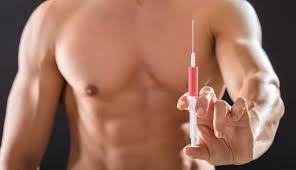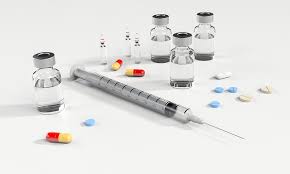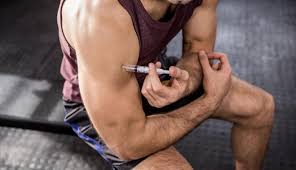Its discovery dates back to the 1920s, when its secretion by the adenohypophysis in animals was discovered.
GH was isolated from humans only in 1956, and in the 70s its structure, somatotropin : it is a peptide hormone consisting of 191 amino acids, stabilized by two disulfide bridges, and reaching a molecular weight of 22 kDa, it is synthesized, accumulated and secreted at the level of adenohypophysis cells in a pulsating manner, which stimulates the development of the body .
GH was first isolated from human cadavers and was used to treat growth hormone deficient patients, but with this outdated method, it was discovered that contamination could occur and eventually lead to Creutzfeldt-Jakob disease . It is a rare neurodegenerative disorder that leads to fatal progressive dementia. The disease is transmissible but appears to be non-infectious, although it can be reproduced in animals by transferring neural tissue extracts from healthy animals. In our case, this manifested itself in the transfer of GH from a dead subject to a living one.

In the 1980s, recombinant hGH (rhGH) was genetically engineered and used along with good results in patients with growth hormone deficiency. This form of the hormone has nearly the same amino acid sequence as hGH and has a molecular weight of 22 kDa. Its abuse in sports is due to its anabolic properties as well as its effect on carbohydrate and fat metabolism. rhGH has been found in swimmers as well as players before taking part in major sporting events. Therefore, the International Olympic Committee (IOC) included GH on the list of prohibited substances.
Meanwhile GH Availability in the regular and black markets. hGH, on the prohibited list, has been included in the S2 class, which includes peptide hormones, growth factors and related substances.
This list includes all growth factors that enhance specific functions such as muscle growth factors, vascularization, energy use, endothelial vascular growth factor and hepatocyte growth factor.
GH secretion in the blood varies depending on normal physiological and pathological conditions, usually in women the concentration is slightly higher than in men.
GH production peaks during puberty, after 20 years its secretion gradually decreases. GH has innumerable functions which, especially at the skeletal muscle level, are mediated by IGF-I, among which we highlight:
- Stimulation of IGF-I production
- Stimulation of cell division
- Stimulating skeletal muscle growth
- Lipolysis stimulation
- Stimulating the immune system
- Improving cognitive connections
Growth hormone secretion
The effects of exercise on growth hormone production in the body are widely described in the literature.

The concentration of hGH in the blood increases with increasing work intensity , and can rise up to 10 times with prolonged physical exertion, but with moderate intensity. During more intense exercise with lactate accumulation equal to 70% of VO2 max for 15-20 minutes, hGH increases 5-10 times. With short-term exertion, growth hormone levels usually reach 15-30 minutes after exercise. Also, it looks like hGH’s answer is closely related to maximum intensity and not to the overall output of work.
In addition to increased secretion, GH may be influenced by other factors, such as increased GH secretion during hypoglycemia, fever and stress while reducing obesity, or with a carbohydrate-rich diet.
GR and doping
It is very difficult to distinguish between physiological increase in GH during exercise and external administration of rhGH, therefore doping 6. This is a problem because the total amount of GH in circulation cannot be measured directly in the case of doping unless sampling conditions are met regularly … GH, as we said, has been considered an ergogenic drug since the late 1980s. Since then, abuse in the sport has grown steadily. Until 2004, rhGH doping was not determined at the Olympic Games in Athens.

Growth hormone is a hormone that has a 5-6 minute half-life in the blood and is low. concentration in urine. The peptide nature of the substance has forced analysts to find methods different from those used for classical analyzes for anabolic and stimulatory steroids, with a relatively low molecular weight. The amino acid sequence of the recombined hormone is identical to that of the major isoform secreted by the adenohypophysis, that is, 22 kDa.
The secretion of GH by the pituitary gland is pulsatile, and therefore levels in the bloodstream are variable. In addition, hGH is considered a stress hormone regulated by factors such as sleep, nutritional status, physical activity, and emotions. Consequently, there is a high individual variability in growth hormone secretion. Quantification of the hormone itself is not sufficient to detect exogenous rhGH . Growth Factor IGF-I and some of its transport proteins (IGFBP-3) have been proposed as possible candidates for indirect detection of rhGH doping. The variability of interindividual secretion is quite high, which makes it difficult to accurately determine the degree of variation in the level.
To detect rhGH, analysts first tried to find it using standard methods, that is, through urine and blood. For detection in blood, two methods have been developed: the direct approximation method and the indirect approximation method. Most doping samples consist of urine collected out of competition or after exercise. The urine was used to detect the peptide, but also other alloying substances. For example, urine has been successfully used to detect EPO .
However, the only way to detect rhGH in urine is to use a highly sensitive immunoassay for quantitation. degree of rhGH in urine. The average concentration of growth hormone in urine is less important than in blood, which ranges from 100 to 1000 times. One idea was to conduct an out-of-competition screening to take advantage of the detection time window for a sufficiently long time. The limitations of this test have been clearly demonstrated due to the large impact of renal failure.
The lack of specificity of the result makes urinalysis less reliable than blood analysis. Today, thanks to advances in anti-doping methods, urine samples are taken in the morning, surprisingly outside of training, for hormone testing. This can be an effective screening solution.
A strategy that appears to be able to detect the presence of rhGH is blood sampling , where the detection of the hormone will be done using two different approaches: direct and indirect.
Indirect approach is based on expanding knowledge of the variability of various dependent hGH factors, alone or in combination, to provide a database of reference values for the concentration of these factors. Consequently, this can lead to the definition of limit levels and the description of anomalous values outside the normal range. This approach, proposed in the mid-1990s, was reviewed by an international jury of endocrinologists, but did not lead to a definitive decision to detect rhGH doping. The advantage of the indirect approach is that when using rhGH, these biological factors are less variable and less sensitive than GH itself. The main goal of the study was to assess the change in these secondary variables during and after exercise. IGF-I and IGFBP-3 are involved in the biological cascade, for example, in bone or osteocalcin metabolism, and are considered good biological indicators of GH doping. These variables showed small but significant changes after exercise. Interindividual variability in growth hormone makes the use of indirect measures almost ineffective in detecting rhGH abuse. Therefore, this indirect method cannot be used as a clear doping test.

The second method used when taking blood samples is the direct approach. This method was developed by the Bidlingmaier Strasburger group in Munich. rhGH has a molecular weight of 20 kDa. When the recombined form is introduced into the body, the proportion of 22 kDa increases over a period of time compared to all other forms in circulation. The test was proposed and used during the Olympic Games in Athens (2004), Turin (2006) and Beijing (2008). To comply with WADA requirements, two blood samples were analyzed, one positive and one negative, to which a direct approach was applied. The test used showed that positive subjects had a significant percentage of 22 kDa per hour. A double test was performed for confirmation. The detection time interval for these tests was found to be 24 to 36 hours after the last injection, depending on the dosage used. It is believed that multiple injections are required for rhGH to be effective. Environmental impacts such as exercise have been evaluated by several authors. They measured different GH isoforms, 22 kDa and 20 kDa, finding a higher concentration of the 22 kDa isoform after exercise, in fact, the ratio of the two isoforms changes when rhGH (22 kDa) is administered.
